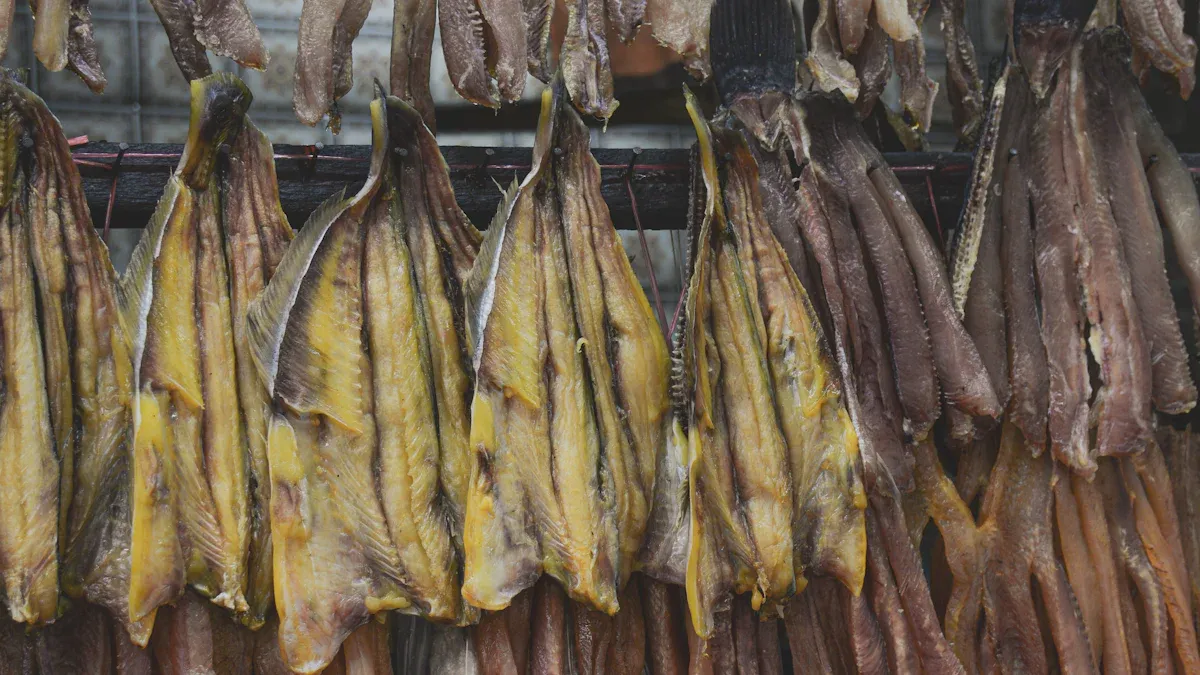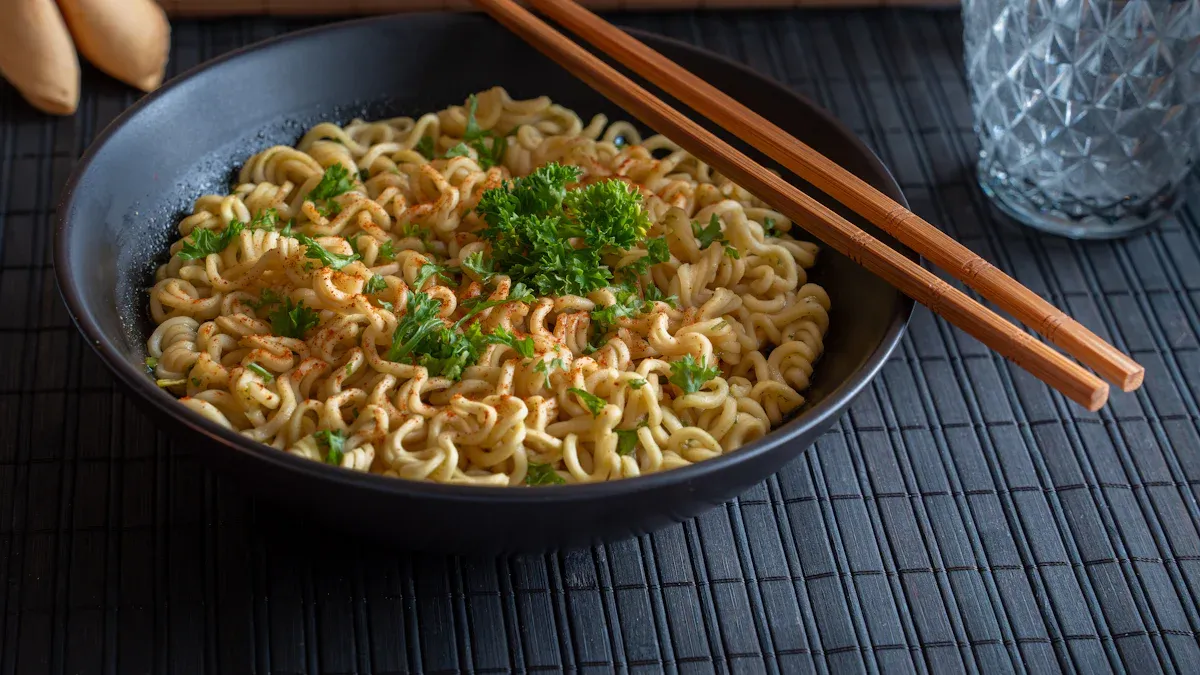
Customized freeze drying solutions play a pivotal role in overcoming challenges faced by Korean food processing plants. These systems ensure the preservation of traditional flavors and textures while enhancing operational efficiency. The Asia Pacific region, including Korea, is witnessing a surge in demand for freeze-dried food, driven by urbanization, higher disposable incomes, and a preference for high-quality, convenient products. This trend underscores the importance of tailored freeze drying technologies in meeting industry needs.
Key Takeaways
- Special freeze drying methods keep the real taste and feel of Korean foods. This helps dishes like kimchi and ginseng stay fresh for people locally and worldwide.
- These systems work better by using 15-30% less energy. This saves a lot of money for food factories.
- Freeze drying keeps about 97% of nutrients. It is great for health-focused people who want natural, high-quality food.
Understanding Freeze Drying Technology

What Is Freeze Drying?
Freeze drying, also known as lyophilization, is a preservation process that removes moisture from food while maintaining its structure and quality. The process involves several stages: preparation, freezing, primary drying (sublimation), secondary drying, and sealing.
- Preparation: Food is sliced or portioned for uniform drying.
- Freezing: Rapid freezing to temperatures between -30°F and -50°F preserves cellular integrity.
- Primary Drying: A vacuum is applied, and the temperature is slightly increased to convert ice directly into vapor.
- Secondary Drying: Residual moisture is removed by further heating under vacuum conditions.
- Sealing: The final product is packaged in moisture-proof containers for long-term storage.
This scientific process ensures that food retains its original texture, flavor, and nutritional value.
Importance of Freeze Drying in Food Processing
Freeze drying plays a critical role in modern food processing. The global freeze-dried food market, valued at $1.8 billion in 2023, is projected to reach $3.8 billion by 2032. This growth reflects the increasing demand for high-quality, preservative-free products. Freeze drying is particularly important for fruits, vegetables, meat, seafood, and dairy products. It preserves taste, color, and nutrition, making it ideal for nutritious snacks, gourmet meals, and global trade.
Advantages Over Other Preservation Methods
Freeze drying offers several advantages compared to traditional preservation methods:
| Aspect | Freeze Drying | Other Methods |
|---|---|---|
| Nutritional Content | Maintains most nutrients | Often degrades nutritional value |
| Shelf Life | Up to 25 years | Generally shorter |
| Space Efficiency | Compact and lightweight | Canned goods are heavier and bulkier |
| Texture and Flavor | Preserves original qualities | Altered in dehydration and freezing |
| Safety | Eliminates bacteria and pathogens | Varies by method |
These benefits make freeze drying a superior choice for preserving food quality and extending shelf life.
Unique Needs of Korean Food Processing

Preserving Traditional Flavors and Textures
Korean cuisine is renowned for its rich flavors and unique textures, which are deeply rooted in tradition. Freeze drying plays a crucial role in preserving these qualities. By sublimating water directly from frozen food, this method ensures that the original taste and texture remain intact. This is particularly important for iconic Korean dishes like kimchi, seaweed snacks, and ginseng products, where flavor authenticity is non-negotiable. Unlike conventional drying methods, freeze drying prevents the loss of volatile compounds responsible for the distinct aroma and taste of these foods. This makes it an ideal solution for Korean food processing plants aiming to deliver authentic products to both local and global markets.
Maintaining Nutritional Value
Nutritional retention is a top priority in Korean food processing, especially for health-conscious consumers. Freeze drying excels in this area by preserving essential vitamins, minerals, and nutrients. For example, studies show that freeze drying retains a higher percentage of nutrients compared to canning or dehydrating.
| Preservation Method | Nutritional Retention | Notes |
|---|---|---|
| Freeze Drying | High | Preserves vitamins, minerals, and nutrients effectively |
| Canning | Moderate to Low | Heat can degrade nutritional value |
| Dehydrating | Low | Can remove up to 50% of nutrients |
This method ensures that Korean food products, such as dried fruits, vegetables, and herbal teas, maintain their health benefits, meeting the growing demand for nutritious and additive-free options.
Meeting Scalability and Export Demands
The global demand for Korean food products continues to rise, driven by the popularity of K-culture and the increasing preference for high-quality, long-shelf-life foods. Freeze drying technology supports scalability by enabling large-scale production without compromising quality. It also meets export demands by extending shelf life and reducing product weight, making transportation more efficient. Additionally, the ability to preserve nutritional value and flavor aligns with consumer preferences for natural and preservative-free foods. Korean food processing plants can leverage these advantages to expand their reach in international markets while maintaining their reputation for quality.
Benefits of Customized Freeze Drying Solutions
Enhancing Efficiency and Reducing Costs
Customized freeze drying solutions significantly improve operational efficiency while reducing costs for food processing plants. These systems enable long-term savings by allowing bulk purchasing of raw materials, particularly seasonal foods, which can then be preserved for year-round use. Additionally, energy-efficient freeze drying systems reduce energy consumption by 15–30%, contributing to lower operational expenses and promoting sustainability. Investments in advanced energy-saving technologies further enhance affordability, making these solutions feasible for a wide range of applications. By optimizing resource utilization and minimizing waste, Korean food processing plants can achieve greater cost-effectiveness and operational efficiency.
Improving Product Quality and Shelf Life
Freeze drying technology ensures superior product quality by preserving the original flavor, texture, and nutritional value of food. This method extends shelf life while maintaining the integrity of the product, making it ideal for industries like food processing, pharmaceuticals, and cosmetics. For example, in the food processing sector, freeze drying has driven global market sales to $3 billion, with an annual growth rate exceeding 7%. The ability to retain nutrients and flavors aligns with consumer preferences for high-quality, preservative-free products. This makes freeze drying an invaluable tool for Korean food processing plants aiming to deliver premium products to both domestic and international markets.
| Industry | Benefits of Customized Freeze Drying | Quantified Impact |
|---|---|---|
| Pharmaceutical | High-quality preservation of biologics and pharmaceuticals, maintaining potency and stability. | 45% of applications in drug formulation processes, particularly for sensitive compounds like proteins. |
| Food Processing | Preservation of flavor and nutrients, longer shelf life, and lightweight packaging advantages. | Global freeze-dried food market sales reached $3 billion, with a growth rate of over 7% annually. |
| Cosmetics | Preservation of active ingredients, preventing degradation from moisture and air exposure. | Longer shelf lives for skincare products without losing efficacy. |
| Nutraceuticals | Preservation of nutrients like vitamins, enhancing bioavailability and convenience for consumers. | Aligned with a wellness industry projected to reach $4 trillion globally. |
Scalability for Diverse Operations
Customized freeze drying solutions offer unparalleled scalability, making them suitable for diverse operations. These systems can handle larger batch sizes without compromising performance, ensuring consistent quality across production scales. Energy-efficient designs minimize energy consumption, reducing costs for high-volume operations. Precise control over temperature, pressure, and drying times allows for the processing of a wide variety of products, from traditional Korean foods to pharmaceuticals and cosmetics. This adaptability enables Korean food processing plants to meet growing domestic and export demands while maintaining their reputation for quality and innovation.
| Key Factor | Description |
|---|---|
| Larger Batch Sizes | Ability to handle increased production without loss of performance. |
| Energy Efficiency | Importance of minimizing energy consumption during the freeze drying process. |
| Precise Control | Need for accurate management of temperature, pressure, and drying times for diverse applications. |
Key Features of Customized Freeze Drying Systems
Advanced Technology for Precision
Customized freeze drying systems incorporate advanced technologies to ensure precision in food processing. These systems provide meticulous control over critical parameters such as temperature, pressure, and drying time. Automation enhances consistency and reduces human error, making the process more reliable. A robust vacuum system plays a vital role in maintaining the necessary conditions for effective sublimation. Additionally, refrigeration and cooling mechanisms regulate freezing and drying rates, ensuring optimal product quality.
The following table highlights key technological features that enhance precision in freeze drying systems:
| Feature | Description |
|---|---|
| Control and Automation | Precise management of temperature, pressure, and drying time, supported by automated processes. |
| Vacuum System | Maintains essential vacuum conditions for efficient sublimation. |
| Refrigeration and Cooling | Regulates freezing and drying rates through advanced cooling systems. |
| Shelf Design | Fluid-filled shelves enable uniform freezing, improving product consistency. |
| Customization and Flexibility | Tailored designs meet specific processing needs, ensuring efficiency and effectiveness. |
These innovations ensure that Korean food processing plants can achieve consistent results while preserving the unique qualities of their products.
Flexibility for Korean Food Products
Freeze drying systems designed for Korean food processing offer exceptional flexibility. They accommodate a wide range of products, from traditional dishes like kimchi and seaweed snacks to herbal teas and ginseng. The ability to adjust drying parameters allows processors to preserve the distinct flavors, textures, and nutritional profiles of these foods. For instance, fluid-filled shelves enable uniform freezing, which is crucial for maintaining the integrity of delicate items like seaweed sheets. This adaptability ensures that processors can meet both domestic and international market demands without compromising quality.
Adaptability to Industry Trends
Modern freeze drying systems align with evolving industry trends, making them indispensable for Korean food processing plants. These systems integrate energy-efficient technologies, reducing energy consumption by up to 30%. This not only lowers operational costs but also supports sustainability goals. The growing demand for preservative-free, high-quality products has further driven the adoption of freeze drying, as it retains up to 97% of nutritional content.
- Energy Efficiency: Advanced designs reduce energy usage, addressing the high costs of traditional methods.
- Food Industry Applications: Freeze drying meets the demand for long shelf life and natural products, preserving taste and nutrients effectively.
- Pharmaceutical Growth: The rise in biologics and vaccine production has increased the need for large-capacity freeze dryers with advanced functionalities.
By staying adaptable, these systems empower Korean food processors to remain competitive in a dynamic global market.
Implementation Strategies for Korean Food Processing
Assessing Specific Plant Requirements
Effective implementation of freeze drying systems begins with a thorough assessment of plant-specific needs. Each Korean food processing facility operates with unique production goals, product types, and operational constraints. Evaluating these factors ensures that the freeze drying solution aligns with the plant’s objectives. Key considerations include the volume of production, the variety of food products, and the desired shelf life. For instance, facilities producing traditional items like kimchi or ginseng require systems capable of preserving delicate flavors and textures. Conducting a detailed analysis helps identify the most suitable equipment and configurations, optimizing both performance and cost-efficiency.
Partnering with Solution Providers
Collaborating with experienced solution providers is crucial for successful system integration. These partnerships offer access to advanced technologies and tailored solutions that address the specific demands of Korean food processing. Solution providers often enhance research capabilities by integrating freeze dryers into educational programs, enabling hands-on learning for students. Additionally, grants and funding opportunities frequently support the acquisition of freeze drying equipment, fostering innovation in both research and production. By leveraging the expertise of solution providers, food processing plants can adopt cutting-edge systems that improve efficiency and product quality.
Training for Seamless Integration
Comprehensive training ensures the smooth adoption of freeze drying systems within a facility. Operators and technicians must understand the equipment’s functionality, maintenance requirements, and safety protocols. Training programs should focus on practical skills, such as adjusting drying parameters and troubleshooting common issues. Hands-on workshops and detailed manuals can enhance learning outcomes. A well-trained workforce minimizes operational disruptions and maximizes the system’s potential. This approach not only boosts productivity but also ensures consistent product quality, meeting the high standards of both domestic and international markets.
Customized freeze drying solutions are essential for Korean food processing plants to preserve quality, enhance efficiency, and scale operations. These systems meet industry demands across sectors:
| Industry | Key Statistic | Impact on Adoption |
|---|---|---|
| Food Processing | $3 billion global market, 7% annual growth. | Rising demand for high-quality, dehydrated foods drives adoption. |
| Nutraceuticals | Wellness industry projected at $4 trillion. | Effective preservation supports health-conscious consumers. |
Adopting tailored systems ensures competitiveness in evolving markets.
FAQ
What makes freeze drying superior to other preservation methods?
Freeze drying retains up to 97% of nutrients, preserves texture and flavor, and extends shelf life to 25 years. It surpasses canning and dehydration in quality and efficiency.
Can freeze drying systems handle diverse Korean food products?
Yes, customized systems accommodate a variety of Korean foods, including kimchi, seaweed, and ginseng. Adjustable parameters ensure flavor, texture, and nutritional integrity remain intact.
How do customized freeze drying solutions reduce costs?
Energy-efficient designs lower energy consumption by 15–30%. Bulk preservation of seasonal ingredients minimizes waste and ensures year-round availability, reducing operational expenses significantly.
Post time: Mar-29-2025





